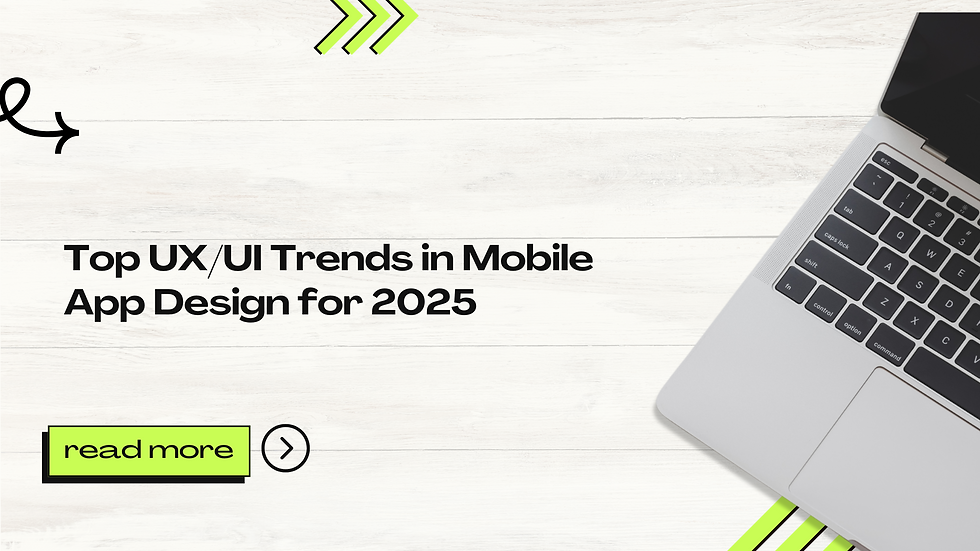Top UX/UI Trends in Mobile App Design for 2025
- seoiphtechnologies
- Dec 3, 2024
- 4 min read

Top UX/UI Trends in Mobile App Design for 2025
The mobile app landscape evolves rapidly, and user experience (UX) and user interface (UI) design play critical roles in ensuring success. As we approach 2025, emerging technologies and changing user expectations are shaping new design trends. In this blog, we’ll explore the top UX/UI trends that will dominate mobile app design in 2025 and how they can enhance user engagement, retention, and satisfaction.
1. Immersive Experiences with AR and VR
Augmented Reality (AR) and Virtual Reality (VR) are transforming mobile app experiences by creating interactive, immersive environments. AR is particularly popular in e-commerce, education, and gaming, while VR is enhancing entertainment and training applications.
Example: Apps like IKEA Place use AR to let users visualize furniture in their space before purchasing.
Design Tip: Focus on seamless integration of AR/VR elements without overwhelming the user. Ensure intuitive gestures and clear feedback.
2. Voice and Conversational UI
Voice User Interfaces (VUI) and chat-based UIs are becoming more prevalent as users seek hands-free, conversational experiences. Apps are integrating AI-powered voice assistants and chatbots to provide personalized support.
Example: Google Assistant and Siri set the standard, but smaller apps are integrating voice control for navigation, searches, and commands.
Design Tip: Ensure that voice interactions are intuitive, with clear visual cues and fallback options for manual interaction.
3. Personalization Powered by AI
Personalization is evolving beyond static preferences. In 2025, AI will analyze user behavior in real-time to deliver hyper-personalized experiences. Apps will offer content, features, and recommendations tailored to individual users.
Example: Netflix and Spotify already excel at personalized content recommendations, and this trend will expand into other industries like healthcare and finance.
Design Tip: Use AI to adapt UI layouts dynamically based on user preferences while maintaining privacy and data security.
4. Neumorphism 2.0: Enhanced Soft UI
Neumorphism, a design style that blends flat design with skeuomorphism, is making a comeback with more practical enhancements. In 2025, expect softer shadows, subtle gradients, and an emphasis on minimalism.
Example: Buttons, cards, and sliders will have a tactile, 3D-like appearance, making the interface feel more tangible.
Design Tip: Use Neumorphism sparingly to ensure accessibility. Combine it with other styles for contrast and usability.
5. Micro-Interactions for Delightful UX
Micro-interactions are small animations or responses triggered by user actions, such as button clicks or swipes. In 2025, they’ll become more sophisticated, offering subtle feedback that enhances the user experience.
Example: A heart animation when liking a post or a subtle vibration when dragging items in a list.
Design Tip: Keep micro-interactions fast and fluid to ensure they enhance the experience rather than distract from it.
6. Biometric-Driven Personalization and Security
Biometric authentication, such as fingerprint scanning and facial recognition, will be more than just a security measure. Apps will use biometrics to personalize content, adapt settings, and provide tailored user experiences.
Example: Apps could adjust brightness or volume based on who is using the device or provide personalized content recommendations.
Design Tip: Ensure biometric data is handled securely, complying with privacy regulations like GDPR.
7. Sustainable and Inclusive Design
As users become more environmentally conscious, sustainable app design will gain prominence. This includes optimizing apps to use less battery, data, and processing power. Inclusive design, ensuring accessibility for users with disabilities, will also be a key focus.
Example: Dark mode not only enhances aesthetics but also saves battery life on OLED screens, while apps like Be My Eyes support visually impaired users.
Design Tip: Prioritize energy-efficient design and implement accessibility best practices, such as adjustable font sizes and screen reader compatibility.
8. Gesture-Driven Interfaces
Gesture navigation is becoming more intuitive, reducing reliance on buttons and taps. In 2025, expect more apps to adopt swipe, pinch, and drag gestures for seamless navigation.
Example: Apps like Tinder popularized swipe gestures, and this trend is expanding into productivity and social apps.
Design Tip: Ensure gestures are discoverable and provide clear visual feedback when a gesture is performed.
9. Advanced Data Visualization
Data-heavy apps, such as finance and health tracking, will focus on delivering complex information in simple, visually appealing formats. Interactive charts, real-time data updates, and animated graphs will enhance comprehension.
Example: Fitness apps like Strava visualize user progress with dynamic charts and comparative data.
Design Tip: Use clean, interactive visuals that allow users to drill down into data without overwhelming them.
10. Continuous Scrolling and Content Feeds
Infinite scrolling has become the norm for social media and news apps. In 2025, more apps will adopt this approach for content consumption, ensuring users stay engaged longer.
Example: Apps like Instagram and TikTok use continuous scrolling to keep users immersed in content.
Design Tip: Implement smart loading strategies to maintain app performance and provide subtle cues for users to track their position in the feed.
Conclusion
The UX/UI trends of 2025 are focused on creating more immersive, personalized, and intuitive experiences for users. As technology evolves, designers must balance aesthetics with functionality, ensuring accessibility and sustainability. By staying ahead of these trends, businesses can deliver apps that captivate users and drive long-term engagement.
If you’re looking to implement these cutting-edge UX/UI trends in your next mobile app, contact IPH Technologies for expert guidance and development services.











Comments